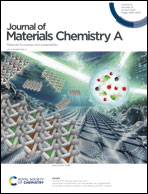Interfacial engineering design induces enriched-defects expediting catalytic conversion kinetics of polysulfides†
Abstract
Plenty of metal sulfides have been employed as electrocatalysts to accelerate sluggish redox reaction kinetics and inhibit the annoying shuttle effect of lithium polysulfides (LiPSs) for lithium–sulfur (Li–S) batteries. Nevertheless, the activity of these catalysts is restricted by the limited number of active sites and poor electrical conductivity, resulting in disappointing cycling performance and rate stability. Herein, CoS2/MoS2 heterostructures anchored on carbon nanotubes (denoted as CoS2–MoS2/CNT) are fabricated by a facile hydrothermal method combined with a vulcanization process, and they serve as a multifunctional interlayer on a PP separator for Li–S batteries to solve the above problems. A series of systematic experiments and in situ spectroscopy elucidate that the interfacial interaction in the CoS2–MoS2 heterojunction not only activates Co sites in favor of anchoring LiPSs and inhibiting the shuttle effect but also synchronously induces the phase transformation of MoS2 from semi-conductive 2H to metallic 1T, and the ample yield of basal and edge defects contributes to the rapid catalytic kinetics of sulfur species. Consequently, a Li–S battery decorated with a CoS2–MoS2/CNT separator delivers a sparkling initial capacity of 921.8 mA h g−1 at 2C with a degradation rate of only 0.036% per cycle over 1000 cycles. This study provides novel insights for interfacial engineering and defect chemistry in durable Li–S electrochemistry and provides a prospective strategy for rational electrocatalyst designs with regard to the diverse energy-storage realm.



 Please wait while we load your content...
Please wait while we load your content...